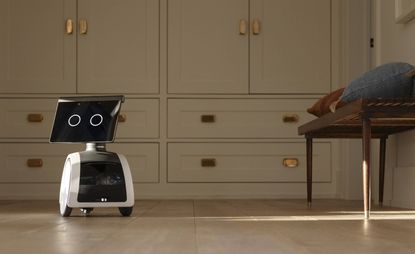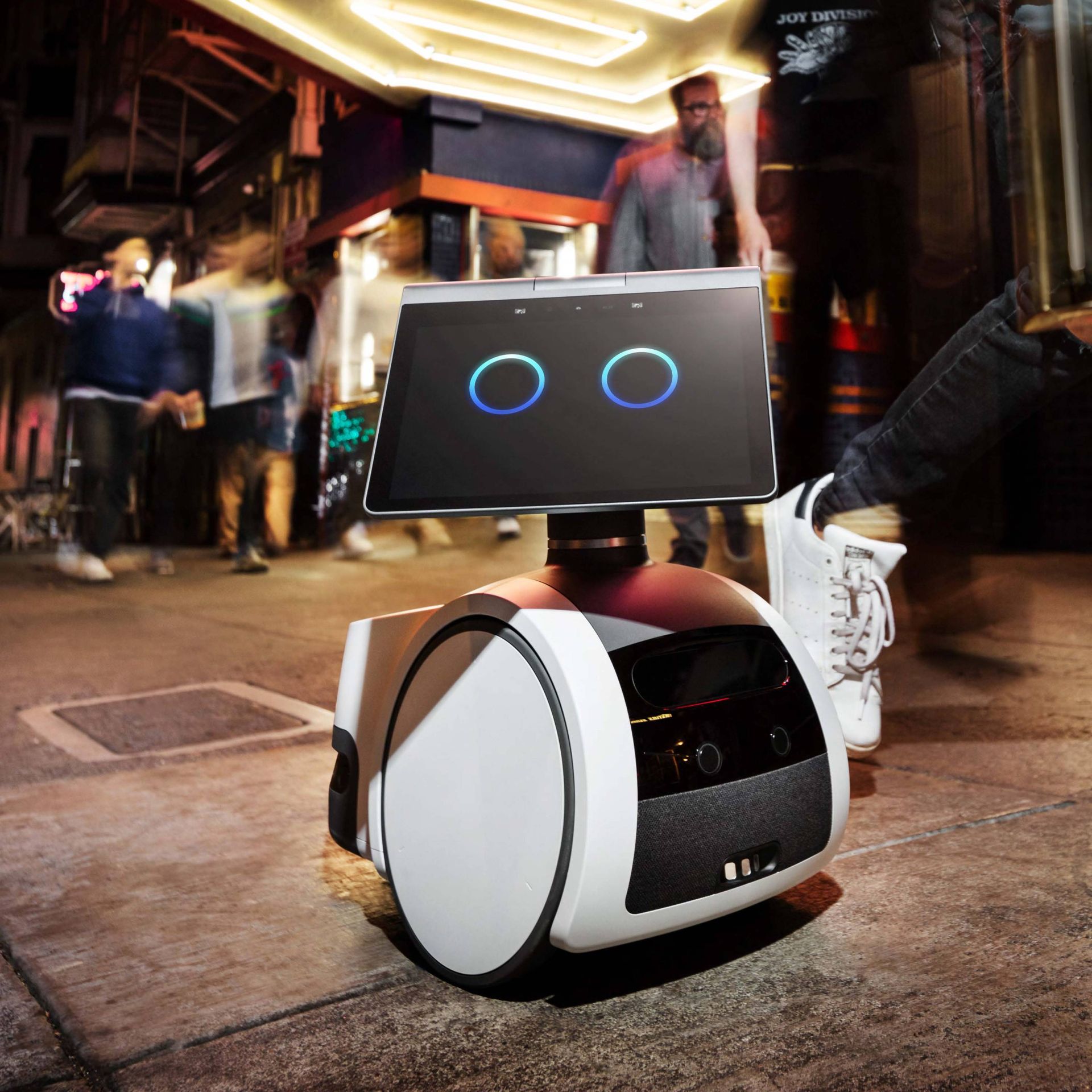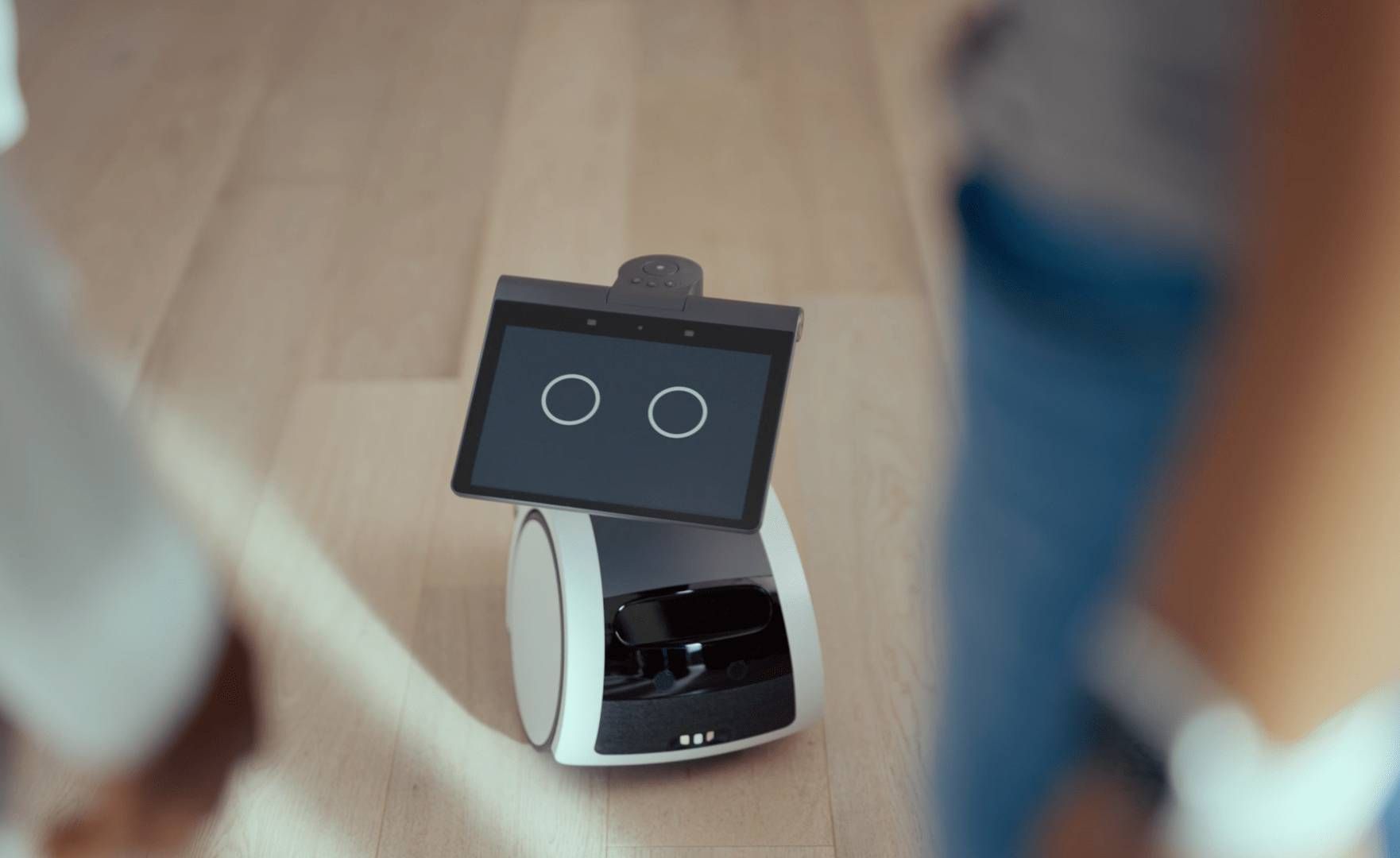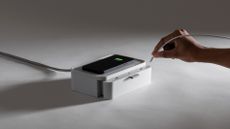The little Amazon Astro is a big company’s first foray into domestic robotics
Amazon is betting big on home automation. Can the friendly-looking Astro ensure our relationship with robots gets off to a healthy start?
- (opens in new tab)
- (opens in new tab)
- (opens in new tab)
- Sign up to our newsletter Newsletter

In August 2022, Amazon spent $1.7bn on iRobot, an American start-up with one foot in military contracts and the other in domestic cleaning robots. iRobot is best known for its Roomba series of machines, the puck-like vacuum cleaning bot that was introduced way back in 2002. It was the latest move by a tech titan that's getting deadly serious about all aspects of robots in the home.
Entirely separately to iRobot, Amazon has been quietly working on a domestic robot of its own. Amazon Astro, first shown last year, is still very much in beta. You can find it on the company’s American store, but at the moment sales are ‘invite only’. We spoke to Chris Green, vice-president of industrial design at Amazon Lab126, the company’s Californian R&D branch, to find out exactly where it’s coming from.
Meet Amazon Astro

Amazon Astro
Green has 15 years’ experience working on Amazon devices, from the Kindle e-reader through to the Fire TV stick and the Echo – all of which were originally developed at Lab126. Amazon Astro is a compact, dustbin-sized device, with two large wheels and a flatscreen for a ‘face’. An extendable periscope supplements the sensors, microphones, and cameras on board, and the whole ensemble can hunt out its charging pad and dock itself when power is running low.
It’s still early days for domestic robots and Astro doesn’t appear to promise much, beyond being a home security camera you can talk to. It's playful, rather than overtly functional. A rear storage compartment can be decked out with things like cupholders and snack dispensers, but Astro has nothing resembling an arm or grabber that can carry out even the simplest task. For now, its job is to look and see.

Amazon Astro
So is Astro a ‘robot without a cause’, as one media commentator put it, or is Amazon simply playing a long game in anticipation of a robot-filled future? Like all big corp designers with a big portfolio, Green knows a lot more than he can say. ‘It’s been a fun journey to get to Astro,’ he begins.
Having moved to California from ‘a small town in the north of England’, the industrial designer clearly revels in the opportunities generated by this major culture shock. At Amazon, he found himself working on products that evolve existing technologies, rather than trying to disrupt whole sectors. That sort of behaviour has been left to Amazon’s retail team.

Early Astro prototypes
Astro is more of the same. ‘We've taken a very different approach,’ Green says, ‘People expect a robot to look like it came from science fiction, but when you actually put one of those robots in somebody's house, it's a little overwhelming.’
Green reiterates Amazon’s primary mission – to ‘remove the friction between the tech and our customers’. ‘We really want to fade into the background. We want Amazon services to be built into every part of your life but in the background,’ he says, citing Kindle Paperwhite as the ‘gold standard’ for a technology that allows you to focus on reading, with no other distractions.
Green also makes the point that Amazon’s devices exist in the fictional worlds of Gene Roddenberry, not George Lucas. ‘In Star Wars, you talked to the robots. In Star Trek, you talk to the room,’ he says, ‘so that’s what we wanted to do with Echo. We [took] all these complex microphones and speaker arrays and created this very simple cylinder. It could have been overtly technology, but instead, it fades into the background.’

Astro follows this ‘elemental’ approach. ‘We admit that we stand on the shoulders of geniuses like Dieter Rams,’ Green says, acknowledging the role that 1960s and 1970s-era electronic minimalism still plays in contemporary tech design. ‘We have very simple shapes, like cubes, cylinders, and spheres,’ he continues, pointing out that these days Amazon doesn’t even apply its logo to its smart devices.
That said, Astro is vastly more complex. ‘It is a simple cylindrical tower which the display is attached to, sitting on a soft round sphere, which is the “belly”. It's got very, very simple circular eyes. There’s no giant learning curve to get your head around the form factor,’ he says. It’s a curiously evolutionary design for a device that’s intended to be a first. ‘Honestly, if we’d jumped right in with a robot [before all the other devices], I think we might have finished up with something more like Boston Dynamics. Something that’s super impressive but which I don’t think customers would want in their homes.’
Learning to trust home robots

Amazon Astro final prototype
So why a robot? What can a moving device achieve that a static object can’t? While the use cases on the website focus on home security, Green doesn’t answer straight away, preferring to explain how important it is to embed Astro with character, charm, and familiarity.
‘Astro will be the first robot most customers will have in their home. And for it to be able to move around their home, it must achieve trust. In order to do that, it needs to show intent and empathy.’

Amazon Astro under the skin
Studies of human reactions and relationships with robots will probably occupy armies of researchers for decades to come. Green flags up the tale of a mobile cart in a Swedish library, an early robot tasked with moving books between stacks. ‘People were super mean and abusive to this thing – getting it stuck in a corner on purpose,’ he says, ‘then one day a librarian stuck a pair of toy googly eyes on it. And it became the most loved thing in the library’
Imbuing an object with personality is clearly a question of programming, product design, and the kind of character design you get in big studio animated movies. ‘There’s a sweet spot between capabilities and realities,’ Green says before making a key distinction. ‘If we’d used Alexa on Astro we would have over-promised like crazy,’ he says. ‘You would have this omniscient thing moving around your house all day… it would have been quite terrifying.’

Amazon Astro
Astro is not Alexa on wheels. Sure, it’ll answer questions, but it has a new voice and a new dataset. The voice uses ‘phonemes’, the distinct sounds that make a spoken language. ‘Out of the box, Astro would be like a fresh baby, that would then [develop] into a toddler, then a teenager, etc.’ Your individual Astro, which isn’t gendered, could therefore ‘grow up’ to be entirely distinct from someone else’s model. ‘If you want it to be an extremely polite butler that always gets out of the way, that’s cool. My version could be very different.’
The primary way of getting all this across is through the device’s simple circular ‘eyes’. ‘They are the best form of non-verbal communication. We wanted to make sure the eyes were understood by everybody,’ Green says, explaining how they started with the universal language of emojis, filtered through Amazon’s animation principles (with a team that includes animators from Industrial Light and Magic).

It feels like a lot of work for what’s ostensibly a jumped-up security camera, albeit one that won’t terrify the family like the Boston Dynamics Spot. The latter, with its wheezing servos, spindly legs, and total absence of any kind of face or expression, seems to revel in its sinister image. People have already taken Spot knock-offs and used them to create roaming gun platforms, not just because they can, but because they’d probably be a brutally effective deterrent.
Science fiction has long propagated the idea that all robots are in some way related, a vast silicon family of disparate forms and functions that have an inherent empathy towards each other. This is a convenient fiction, for it allows the blank personality of the assembly line robot or autonomous warehouse shuttle to bleed into the deeply researched anthropomorphic qualities of ‘social’ robots like Astro and Fuseproject's Moxie (opens in new tab).

In truth, the differences are vast, and are only going to get further apart. For all its careful choreography of expression and movement, plus the evolutionary nature of its ‘personality’, Astro is still very much an experiment. The experimental subjects, however, are probably us. On the surface, Astro is obviously quirky and cute, a little helper in the home, but once the device is filtered through Amazon’s vast dataset, it swiftly takes on a more sinister air.
Amazon is probably the world’s largest employer of industrial robots. A number often cited is 200,000, the vast majority of which buzz around its semi-automated delivery centres in an autonomous, personality-free blur of uncomplaining activity (as opposed to its 1.6 million flesh and blood, union-demanding, human employees).

Before Astro has even rolled across the threshold of any old paying customer’s home, you can already buy plenty of knock-offs. Miko, Misa, Vector, Skymee, Enabot, and countless other, presumably much lesser robots. It’s similar to the motley pack of robot dogs that waddled in the footsteps of Sony’s popular Aibo. Many of these have a singular purpose – security, pet cam, educational toy – and some might even offer Alexa built in. Listening to Green enthuse about the design journey, it’s pretty clear that none of these devices will even come close to what Astro offers.
However, having established that the world of robots is not one big, interconnected happy family, might we expect Astro to undergo some kind of mission creep once it’s got itself through the door? Emotionally anchored by its burgeoning personality, burnished by constant online connectivity, and piping back information from its array of sensors and cameras, Astro is a kawaii cuckoo for the digital age.

‘We want people to trust Astro and for Astro to be around for a long time,’ says Green, occasionally referring to this device as the ‘first Astro’.
His team took inspiration from sci-fi literature as well as art direction and special effects and although Green stresses that ‘we definitely don't want to force anything on anybody’, there’s a very real chance that Astro and its successors will end up with the same emotional capital as a much-loved family pet. A pet that holds enormously valuable insight into your viewing and shopping habits. Other badly-lit avenues of the AI-powered (r)evolution are also opening up, such as the recent demonstration of an Alexa equipped with the deep-faked voice of a recently deceased relative. Your grandmother can read bedtime stories forever…

Boston Dynamics and its ilk might be building more powerful and agile machines, but right out of the box their machines have an emphasis on the industrial – user empathy and uncanny valley be damned. Spot is designed to ‘elevate predictive maintenance with automated thermal inspections’, and although it probably could be programmed to give your cat a treat while you’re at work, the potential anxiety (for both you and your cat) probably isn’t worth it.
Green’s enthusiasm for the Astro project is tangible. ‘Do we believe that there's going to be a robot in everybody's house in a hundred years? Yes. 100 percent,’ he says emphatically, ‘The whole thing about this first launch is to get people to trust robots. Because without trust, you'll never have these humanoid robots in the future. You’d just be too terrified… We want you to have empathy to help these robots learn.’

Practically every world culture imposes personalities on inanimate objects, humanising them in a way that distracts us from their lack of sentience. The arrival of objects with personalities that grow and evolve – regardless of the levels of coding trickery and sleight of hand used to sustain those personalities – will presumably usher in a new way of relating to technology.
Amazon is frighteningly good at what it does. With its exabytes of our data squirrelled away around the globe, Astro will become a pansophical android that’s hard to ignore, let alone dispose of. Might you be able to cut and paste five years’ worth of Astro knowledge into new, shinier hardware? Will anyone simply press ‘delete’ and scrub out the far-reaching digital memories of a trusted family member? Who gets the Astro in the divorce? And what does it know?

Astro is currently an invite-only product, along with the equally futuristic 'Ring Always Home Cam', a home security drone and docking station that can supplement the little robot’s bathmophobia. Bold technological advances are often the harbinger of unintended consequences. If Green is right, and Astro is the spearhead that ushers in universal robotics, we might have little choice but to sit back and take it.
Whatever happens, the Luddites amongst us will be grateful to hear that nearly 60 years after the Daleks, the most compelling domestic robot ever offered can still be thwarted by the humble staircase.
INFORMATION
Amazon Astro Household Robot
amazon.com (opens in new tab)
Jonathan Bell has written for Wallpaper* magazine since 1999, covering everything from architecture and transport design to books, tech and graphic design. He is now the magazine’s Transport and Technology Editor. Jonathan has written and edited 15 books, including Concept Car Design, 21st Century House, and The New Modern House. He is also the host of Wallpaper’s first podcast.
-
 Men’s engagement rings for modern grooms
Men’s engagement rings for modern groomsMen’s engagement rings, whether classic or colourful, make for sentimental tokens
By Hannah Silver • Published
-
 Longchamp unites with D’heygere on a playful collection made to ‘transform the everyday’
Longchamp unites with D’heygere on a playful collection made to ‘transform the everyday’Inspired by Longchamp’s foldaway ‘Le Pliage’ bag, this collaboration with Paris-based jewellery and accessories designer Stéphanie D’heygere sees pieces that ‘transform and adapt’ to their wearer
By Jack Moss • Published
-
 Last chance to see: Marc Newson’s all-blue designs in Athens
Last chance to see: Marc Newson’s all-blue designs in AthensGagosian gallery Athens presents new blue furniture and objects by Marc Newson
By Rosa Bertoli • Published
-
 New Kindle Scribe crowns 15 years of evolution of Amazon’s e-reader
New Kindle Scribe crowns 15 years of evolution of Amazon’s e-readerWe review the latest and most sophisticated Kindle ever made, the Amazon Kindle Scribe, and look back over the device’s 15-year evolution and how it squares up to rivals like the reMarkable 2
By Jonathan Bell • Published
-
 We Are Rewind takes tape into the 21st century
We Are Rewind takes tape into the 21st centuryWe Are Rewind’s self-consciously retro Cassette Player is designed to tap into our ongoing obsession for analogue formats. Just the thing for your mixtape 2022?
By Jonathan Bell • Published
-
 Ten years of Microsoft Surface: the company’s design team on what comes next
Ten years of Microsoft Surface: the company’s design team on what comes nextThe Microsoft Surface series is a well-established line of premium mobile devices. How are its designers continuing to innovate?
By Jonathan Bell • Published
-
 Wallpaper* wants… ten best-designed wireless chargers for Apple devices
Wallpaper* wants… ten best-designed wireless chargers for Apple devicesLooking to get rid of wires? Our top ten elegantly designed MagSafe-compatible wireless charging stations will help you find your way through the tangle
By Jonathan Bell • Published
-
 Microsoft goes William Morris: the Surface Pro 9 Liberty Special Edition is now available
Microsoft goes William Morris: the Surface Pro 9 Liberty Special Edition is now availableThe Microsoft Surface Pro 9 Liberty Special Edition is a hybrid tablet and laptop embellished with a bespoke design
By Jonathan Bell • Published
-
 Google accelerates home WiFi with shapely new Nest WiFi Pro router
Google accelerates home WiFi with shapely new Nest WiFi Pro routerGoogle’s newest domestic device is inspired by ceramic art and incorporates the newest ultra-fast standard of WiFi technology, WiFi 6E
By Jonathan Bell • Published
-
 Cut your own grooves with Teenage Engineering’s new Record Factory
Cut your own grooves with Teenage Engineering’s new Record FactoryThe PO-80 Record Factory from Yuri Suzuki and Teenage Engineering is a musical toy with a serious side
By Jonathan Bell • Last updated
-
 Hands on with new Nothing Phone (1): a clearly different smartphone
Hands on with new Nothing Phone (1): a clearly different smartphoneNothing Phone (1) launches, hitting the sweet spot between price, performance, and efficiency, and promoting the simplification of your smartphone life
By Jonathan Bell • Last updated










